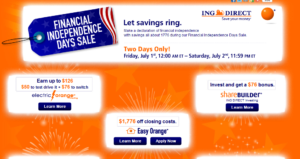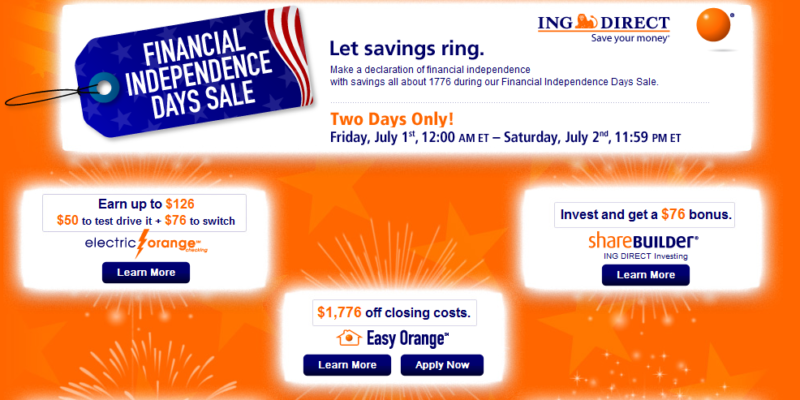LRN got hacked this morning. Thankfully, I backup weekly and subscribe to my own RSS feed. 20 minutes to total restoration.
ING Rocks

I just got an email from INGDirect. To celebrate Independence Day, they are having a sweet, sweet sale.
You can:
- Open a checking account and get between $50 and $126 for doing so.
- Open a Sharebuilder account and get $76 to start buying stocks.
- Get $1776 knocked off the closing costs of a mortgage.
- Get $76 in a new IRA, to give you a little boost for retirement.
Take advantage of all of that and you’ll get $2054 in cash or discounts.
Seriously, this deal rocks. If you don’t have an INGDirect account, get one. There are no overdraft fees and no monthly fees.
The sale ends tomorrow at midnight, so hurry.
Please vote for me
My post 4 Ways to Flog the Inner Impulse Shopper is up in Free Money Finance’s March Money Madness tournament. Please take a moment to vote for me(Flog).
Thank you. That is all.
Breaking Bad: The Economics of Meth

In AMC’s “Breaking Bad,” Walter White plays the role of chemistry teacher turned meth producer and drug kingpin. While it certainly makes for good television to think about the profits available to someone willing to trade in illegal drugs, the mountain of money that Walter makes by the end of the series is actually not that unrealistic. Meth has a street value that approaches $30,000 dollars per pound. Not only that, but Walter displays a deceptively keen business acumen, especially for a chemistry teacher. A number of keen decisions allowed Walter White to become as successful as he has.
Production Costs
As any business owner knows, merchandise costs are a major portion of any operating budget. Mr. White keeps his profit margins robust in a number of ways. The first of these is by managing his production costs. When he started out in the business, Walter simply stole the majority of the required chemicals from the high school where he worked. This allowed for the product to be sold at a substantial profit when compared to producers who are required to invest more upfront.
Location, Location, Location
On top of his discounted production, Walter was able to stay ahead of the competition both literally and figuratively by utilizing his RV for production. Typically, meth is produced in a laboratory environment, which requires a building. This adds an additional cost of rent to the typical business profile. Walter, on the other hand, produced out of his RV in the early stages of his business’ growth, further increasing his profit margin.
Distribution
On the production side of the economy, a major consideration is distribution costs. While most of Walter’s competition used pricey, established lines of distribution for their products, he cut out the middle man by distributing his product with his team. This caused major disruptions to his business when his competitors tried to kill him. However, while he was able to accomplish this model, Walter was the beneficiary of increased profits. Then, when he killed his competition, he was able to return to the healthy margin he enjoyed previously.
Advertising
Many new products are launched with a full blown media campaign. This is a costly proposition. Walter, instead, relied on the quality of his product to speak for itself. This competitive advantage reduced the need for an extensive advertising budget. Furthermore, after a period of time, his product became a preferred choice by consumers everywhere. While he was required to distribute a few loss leaders at times, Walter kept the advertising costs down and profited greatly.
So, while it may seem like Walter White was simply a chemistry teacher who got lucky, it’s clear that he actually had a specific plan for his upstart business. By following a few standard economic principles, he was able to increase his margins at the crucial beginning phase of his business, and had established himself as a leader in the market when he chose to expand
Related articles
Budget Lesson, Part 4
Part 4 of the Budget Lesson series. Please see Part 1, Part 2, and Part 3 to catch up. The Google Doc of this example is here.
The final category in my budget is “Set-aside funds”. These are the categories that don’t have specific payout amounts and happen at irregular intervals. When my car is paid off, there will be a car fund added to the list, instead of a new car payment.
- Parties – We throw two parties each year; a Halloween party and a summer barbecue. We also have three children who have varying expectations and needs for their birthday parties.
- Gifts – I don’t buy presents for my friends, and the number of relatives I buy gifts for has decreased dramatically over the years. I do, however, buy birthday and Christmas presents for my wife and kids and I participate in some form of gift exchange with my brothers and their wives. Combined, we set aside about $100 per month for parties and presents.
- Pet Care – We have four cats and a dog. This is to cover cat litter and food the bunch. We have too many pets, but we can’t give them away. They are family. However, there is a moratorium on new animals for a few years. Two cats and a dog are our hard limit.
- Car Repair – Cars break. Tires wear out. This isn’t a surprise, and it certainly isn’t an emergency.
- Warranty Fund – We are building up our own “Warranty Fund“, to replace appliances when they break. I’d rather have the interest accruing than see this as a line-item fee on any of my bills.
- Medicine/Medical – Kids get sick and prescriptions need to be filled. We figure our monthly prescriptions plus one office visit per month, but the money accrues in this fund. On low months, we have more, so we can cover the visits during flu season.
- In The Hole – This isn’t actually a fund we set aside. If, for some reason, we go over budget one month, it gets entered here to immediately pay ourselves back for the over-spend. This month, this number is $170, which is how high we went over for Christmas. Since we have all of the “Set asides” and non-monthly bills stored in the same account, there was no actual debt, just this “paper” debt to ourselves. This serves the combined purposes of a mild punishment for overspending and a method to get back on track.
That is my entire budget laid out. As the series continues, I’ll be examining how I have lowered the bills, how I could lower them more, and how I’ve screwed them up.







